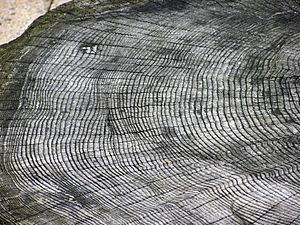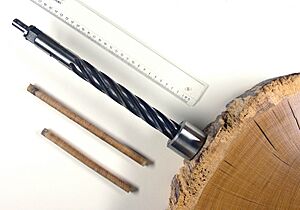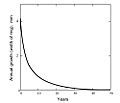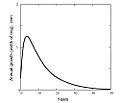Dendrochronology facts for kids
Dendrochronology is a scientific way to find out the age of wood. It's also called tree-ring dating. This method uses the unique patterns of growth rings found inside trees. For many types of wood, scientists can figure out the exact year each ring was formed.
Dendrochronology is used for several important things:
- It helps with radiocarbon dating. This is a method to find the age of very old things. Tree rings help make radiocarbon dates more accurate.
- It's used in archaeology. This helps scientists date old buildings, wooden tools, and other ancient objects.
- It helps study past climates. By looking at tree rings, scientists can learn about weather conditions from long ago. This field is called palaeoecology.
In some parts of the world, this method can date wood back thousands of years. The oldest "fully anchored chronologies" go back more than 11,000 years. "Fully anchored" means the dates are absolutely certain and proven.
How Tree-Ring Dating Started
Dendrochronology gets its name from Greek words: dendron (tree), khronos (time), and -logia (study of). It was developed in the early 1900s by an astronomer named A.E. Douglass. He started the Laboratory of Tree-Ring Research at the University of Arizona.
Douglass was studying sunspots, which are dark spots on the Sun. He thought that changes in the Sun's activity might affect Earth's climate. He believed that tree-ring growth patterns would record these climate changes.
Other people had noticed tree rings and their connection to wet and dry years before Douglass. Leonardo da Vinci wrote a short note about it. Charles Babbage also had a similar idea in 1837.
How It Works
Many trees in temperate zones (places with four seasons) grow one new ring each year. The newest ring is always right next to the bark. As a tree grows, its rings form a unique pattern year after year. This pattern shows the climate conditions the tree lived through.
For example, if there was plenty of rain and a long growing season, the tree would grow a wide ring. If there was a drought (a very dry period), the ring might be very narrow. Sometimes, if conditions change a lot in one year (like a mid-summer drought), a tree might even form more than one ring. Scientists have ways to fix these issues by comparing trees from different areas.
Missing rings are very rare in trees like oak and elm. One famous example of a missing ring in oak trees happened in 1816. That year was known as the Year without a Summer because of very cold weather.
Trees from the same area usually show similar patterns of ring widths for the same time period. Scientists can compare these patterns. They match them ring by ring with other trees from the same region and similar climate. By doing this, they can build up long timelines, called chronologies. These timelines go back in time using both living trees and old wood.
This method allows scientists to date wood from old buildings or archaeological sites. They match the wood's ring pattern to a known chronology. This technique is called cross-dating. It helps them find the exact age of the wood.
Tree-ring dates can be extended even further back in time, up to 26,000 years ago. This is done by using other methods. These methods include studying layers of marine sediment (stuff that settles at the bottom of the ocean) and growth rings in corals.
Images for kids
-
A cross-section of a Pinus taeda (Loblolly Pine) tree, showing its annual rings.
See also
 In Spanish: Dendrocronología para niños
In Spanish: Dendrocronología para niños







